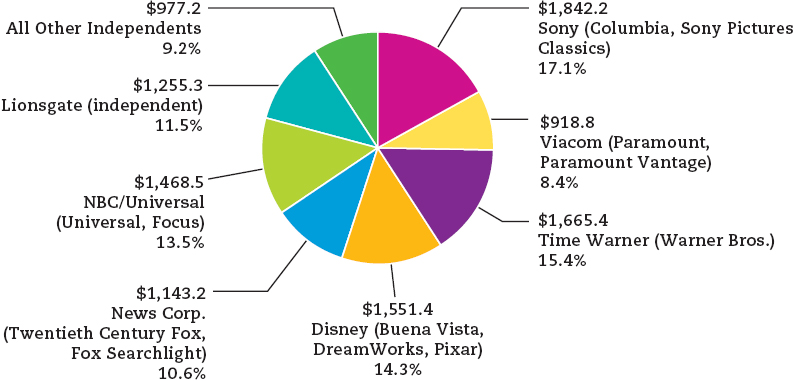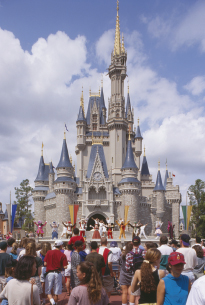The Major Studio Players
The current Hollywood commercial film business is ruled primarily by six companies: Warner Brothers, Paramount, Twentieth Century Fox, Universal, Columbia Pictures, and Disney—the Big Six. Except for Disney, all these companies are owned by large parent conglomerates (see Figure 7.2). The six major studios account for more than 90 percent of the revenue generated by commercial films. They also control more than half the movie market in Europe and Asia. One independent studio, DreamWorks SKG—created in 1994 by Steven Spielberg, former Disney executive Jeffrey Katzenberg, and sound recording tycoon David Geffen—began to rival the production capabilities of the majors with films like Shrek 2 (2004), Anchorman (2004), and Madagascar (2005). Nevertheless, even DreamWorks could not sustain the high costs of an independent studio, and in 2009 it struck a six-year distribution deal with Disney. In the United States, three independent studios—sometimes called mini-majors—have maintained modest market share for a number of years: Lionsgate (The Hunger Games; the Twilight series), which purchased indie Summit Entertainment in 2012; the Weinstein Company (Django Unchained and Silver Linings Playbook); and Relativity (Safe Haven).

Note: Based on gross box-office revenue, January 1, 2012–December 31, 2012. Overall gross for period: $10.822 billion.
Source: Box Office Mojo. Studio Market Share, http://www.boxofficemojo.com/studio/.
In the 1980s, to offset losses resulting from box-office failures, the movie industry began to diversify, expanding into other product lines and other mass media. This expansion included television programming, print media, sound recordings, and home videos/DVDs, as well as cable and computers, electronic hardware and software, retail stores, and theme parks such as Universal Studios. To maintain the industry’s economic stability, management strategies today rely on both heavy advance promotion (which can double the cost of a commercial film) and synergy—the promotion and sale of a product throughout the various subsidiaries of the media conglomerate. Companies promote not only the new movie itself but also its book form, soundtrack, calendars, T-shirts, Web site, and toy action figures, as well as “the-making-of” story on television, home video, and the Internet. The Disney studio, in particular, has been successful with its multiple repackaging of youth-targeted movies, including comic books, toys, television specials, fast-food tie-ins, and theme-park attractions. Since the 1950s, this synergy has been a key characteristic in the film industry and an important element in the flood of corporate mergers that have made today’s Big Six even bigger.
The biggest corporate mergers have involved the internationalization of the American film business. Investment in American popular culture by the international electronics industry is particularly significant. This business strategy represents a new, high-tech kind of vertical integration—an attempt to control both the production of electronic equipment that consumers buy for their homes and the production/distribution of the content that runs on that equipment. This began in 1985 when Australia’s News Corp. bought Twentieth Century Fox. Sony bought Columbia in 1989 for $4 billion. Vivendi, a French utility, acquired Universal in 2000 but sold it to General Electric, the parent of NBC, in 2003. Comcast bought a controlling stake in NBC Universal in 2009 and government agencies approved the merger in 2011. In 2006, Disney bought its animation partner, Pixar. It also bought Marvel in 2009, which gave Disney the rights to a host of characters, including Spider-Man, Iron Man, Hulk, the X-Men, and Fantastic Four. In 2012, Disney bought Lucasfilm, gaining control of the Indiana Jones and Star Wars franchises, plus the innovative technologies of George Lucas’s famed Industrial Light & Magic special effects company. (See “What Disney Owns.”)
WHAT DISNEY OWNS
Consider how Disney connects to your life; then turn the page for the bigger picture.
MOVIES
- Walt Disney Pictures
- – Walt Disney Animation Studios
- – Pixar Animation Studios
- – Touchstone Pictures
- – Marvel Studios
- – Disney Nature
- – Lucasfilm
- Walt Disney Studios Motion Pictures International
- Walt Disney Studios Home Entertainment
MUSIC
- Disney Music Group
- – Walt Disney Records
- – Hollywood Records
- – Disney Music Publishing
PUBLISHING
- Disney Publishing Worldwide
- ESPN The Magazine
- Marvel Entertainment
- Wondertime magazine
- FamilyFun magazine
TELEVISION/RADIO
- Disney-ABC Television Group
- – ABC Entertainment Group
- – ABC News
- – ABC Family
- – Disney Channel Worldwide
- – Hyperion
- – A&E/Lifetime
- ESPN, Inc. (80 percent)
- ABC-owned television stations (10)
INTERNET/MOBILE CONTENT
- Disney Interactive
- – Disney.com
- – ESPN360.com
- – Mobile ESPN
- – Club Penguin
DISNEY PARKS AND RESORTS
- Disneyland Resorts and Parks (10 locations)
- Disney Cruise Line
- Adventures by Disney
- – Walt Disney Imagineering
WHAT DOES THIS MEAN?
Disney’s reach touches people of every age all around the world.
- Revenue and Employees. In 2012, Disney had revenues of about $42.3 billion and employed 166,000 people.1
- Movies. As of October 2012, Disney has released domestically 980 full-length live-action features, 90 full-length animated features, and hundreds of shorts.
- Television. Disney operates the ABC Television Network, which reaches 99 percent of all U.S. television households.
- Sports. For users seeking sports content on mobile devices, 75 percent rely on ESPN.
- Disneyland. More than 500 million visitors have passed through the gates of Disneyland in Anaheim, California, since it opened in 1955. Disneyland Paris welcomes more visitors annually than the Eiffel Tower and the Louvre combined.
- Consumer Products. Disney Consumer Products is the world’s largest licensor, putting Disney characters on everything from children’s laptops to maternity wear.
- Publishing. Disney is the world’s largest publisher of children’s books and magazines, reaching families in 85 countries and 75 languages.
- Radio. The ESPN Radio Network is carried on more than 350 stations, making it the largest sports radio network in the United States.
- Global. Disney operates more than 100 worldwide channels, up from 19 a decade ago.
